18th July 2017 / No Comments Yet

Woman /
25 December 1965
Godfrey Winn is a name almost forgotten today, but thanks to the wonders of Wikipedia, I’m able to tell you that he was a respected war journalist, actor and author. However, at this point, Winn was a much-loved columnist, writing for women, and this advert clearly shows him in this role.
Two things clearly leap out at me from this ad copy; that being in your 40s was considered vaguely shameful for women back then, whereas the stigma is considerably reduced nowadays, and that her appearance is much older than would be expected of someone her age now. Not only does she LOOK older than she is by modern standards, but her description of her ‘rheumatism’ is akin to something I might expect from someone at least 20 years older than her. Getting older in the 1960s does sound a little like Logan’s Run, but it’s important to realise that life expectancy for women when Mrs Baker was born was around 60, so perhaps it’s not that surprising that her attitude might be one of a woman approaching old age.
I’ve put rheumatism in quotes for a reason, as Fynnon Salt, from what I can gather online, is another name for Epsom Salts, still sold today as a treatment for aching muscles, and rheumatism is nowadays recognised as an umbrella term for various muscular aches. Given the description of her job and her age, I would expect Mrs Baker to experience pain in her legs, but the attitude in the advert suggests that this is an actual condition, rather than a normal reaction to fatigue. Plenty has been written about the ‘medicalisation’ of human pain, and it continues to be a controversial and complicated subject, but this seems to typify a common attitude of the time, where normal pain is seen as something wrong with the person, rather than the pressures they are subject to.
Tags: 1960s, blatant sexism, dodgy advice, health
2nd July 2017 / 1 Comment
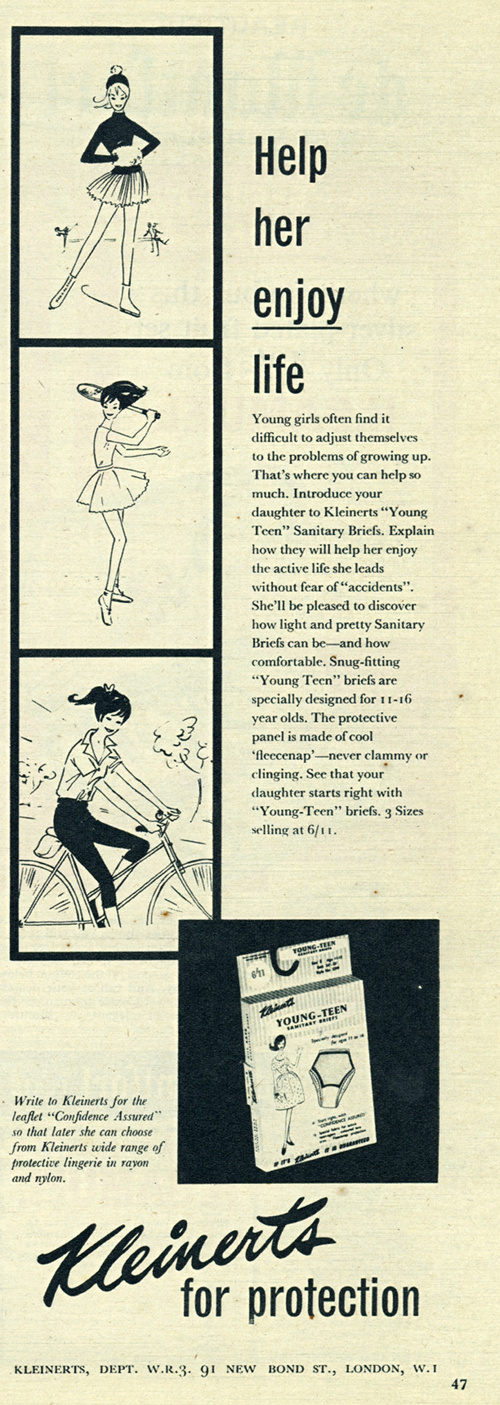
Woman's Realm /
15 July 1961
These appear to be ‘Pull-up’ pants for teenage girls, so I’m not all that surprised that they didn’t become popular. I suspect part of the failure might be the ‘fleecenap’ that’s meant to absorb menses, although I can’t say for sure how it measured up against other sanitary alternatives of the time. Another attempt was made a few years later in the shape of Nikini, but the failure of this product suggests that, amazingly, not all women are made to the same shape and size, and so they’re better off deciding for themselves exactly where their sanitary protection should sit. A secondary reason why this kind of product isn’t likely to be making a comeback is the loss of social stigma around tampons, and even the reputation of menstrual cups is changing from being too ‘hippy’, due to some canny advertising praising their ecologically-friendly credentials.
Tags: blatant sexism, health, periods, social history, Tampax, teenagers
8th February 2017 / No Comments Yet
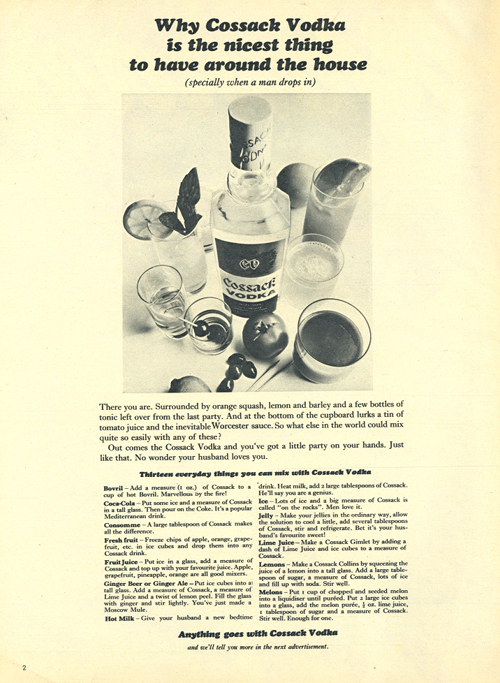
Woman /
25 December 1965
I think we can probably tell that we’re in the era of Babycham being an acceptable drink for women, with stout if it was decided you needed the iron. What is interesting is that vodka, if anything, is seen much more as a drink for women and young men nowadays, which I guess is progress, even if there’s a hint that vodka’s a good way to drink without imbibing too many calories. Still, there’s some fascinating serving suggestions here, including the now everyday ‘vodka with coke’, so bottoms up!
Tags: 1960s, alcohol, blatant sexism
15th January 2017 / No Comments Yet
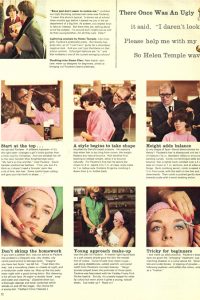
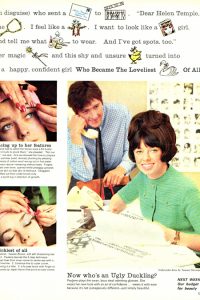
Woman /
25 December 1965
Now don’t get the wrong idea. I’m not against makeovers per se, and I’m a great believer in enhancing your best features, but *honestly*, this poor young woman.
Obviously, with this being the 1960s, the ability of this woman to get ‘boys’ to notice her is all-important, and naturally, poor Paulene had to ‘admit’ that her eyebrows were bushy (gasp!), leading Woman to advise her on a plucking method that would give her the least unnecessary pain. We’re also taken through a make-up routine to bring out her ‘latent prettiness’, which raises an interesting question; what does that actually *look* like?
The new hairstyle is quite something, too; a perfectly reasonable bob is turned into something more suited to a member of the Household Cavalry. In fact, I’m reminded of the makeover that poor Kate Middleton was subjected to when she became the Duchess of Cambridge. Still, now she’s getting admiring leers from her male co-workers, she’ll soon be able to bury any ambitions she might have had and get married. Thanks, Woman!
Tags: 1960s, beauty, blatant sexism, dodgy advice, fashion
6th January 2015 / No Comments Yet
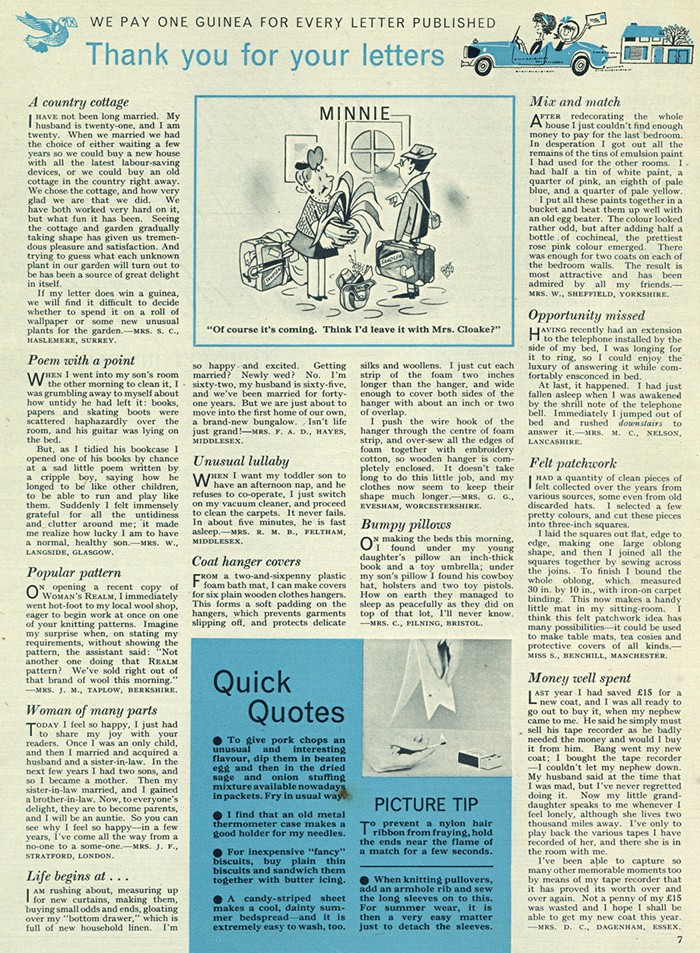
Woman's Realm /
15 July 1961
The ‘Woman of many parts’ letter on here nearly broke my heart. What sort of messages must this woman have got from society to believe that she was a ‘no-one’ when she was a unmarried only child?
Tags: blatant sexism, marriage, motherhood, social history
26th June 2014 / No Comments Yet
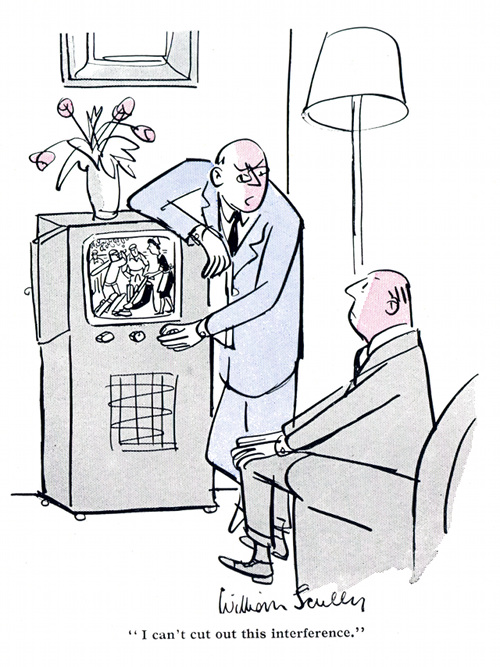
Men Only /
July 1950
What? I mean, what? It’s because of arseholery like this that cleaners have to work stupidly early, so overprivileged nobs in offices can’t actually see the hard work that goes into making their environment clean and tidy. How is this even a fucking joke? How many more questions will I ask that I well know the answer to?
Tags: blatant sexism, social history
19th January 2014 / No Comments Yet

Men Only /
September 1951
I think the copywriters might have sunk several pints themselves in the sun, because this advert has many words, few of which make any real sense. The comment referring to ‘womanlike’ is very confused, and it’s hard to make out who is actually being sold to. Perhaps this is the sort of rambling mess these ad men offered their own wives when stumbling back from a long liquid lunch.
Tags: blatant sexism, dodgy advice, emotional blackmail, marriage, retail, social history
3rd December 2013 / 3 Comments
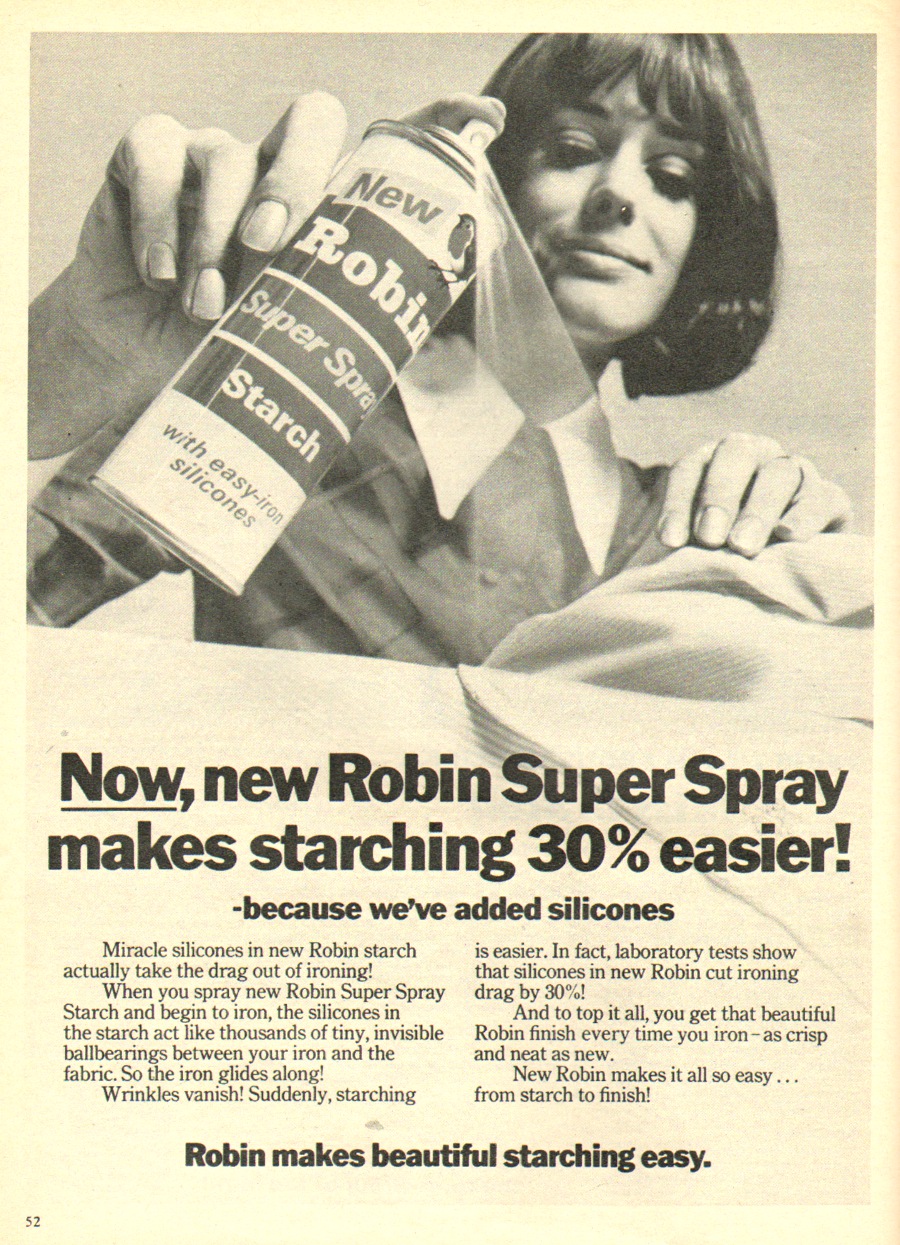
Woman's Weekly /
11th July 1969
Spray starch is still sold, of course, but starched clothes have been out of fashion for quite some time. It seems that the ‘easy care’ revolution of the 1960s changed attitudes forever, and I’m not surprised. Who, after all, really wants to make their life more difficult?
Tags: blatant sexism, household, retail
6th November 2013 / No Comments Yet
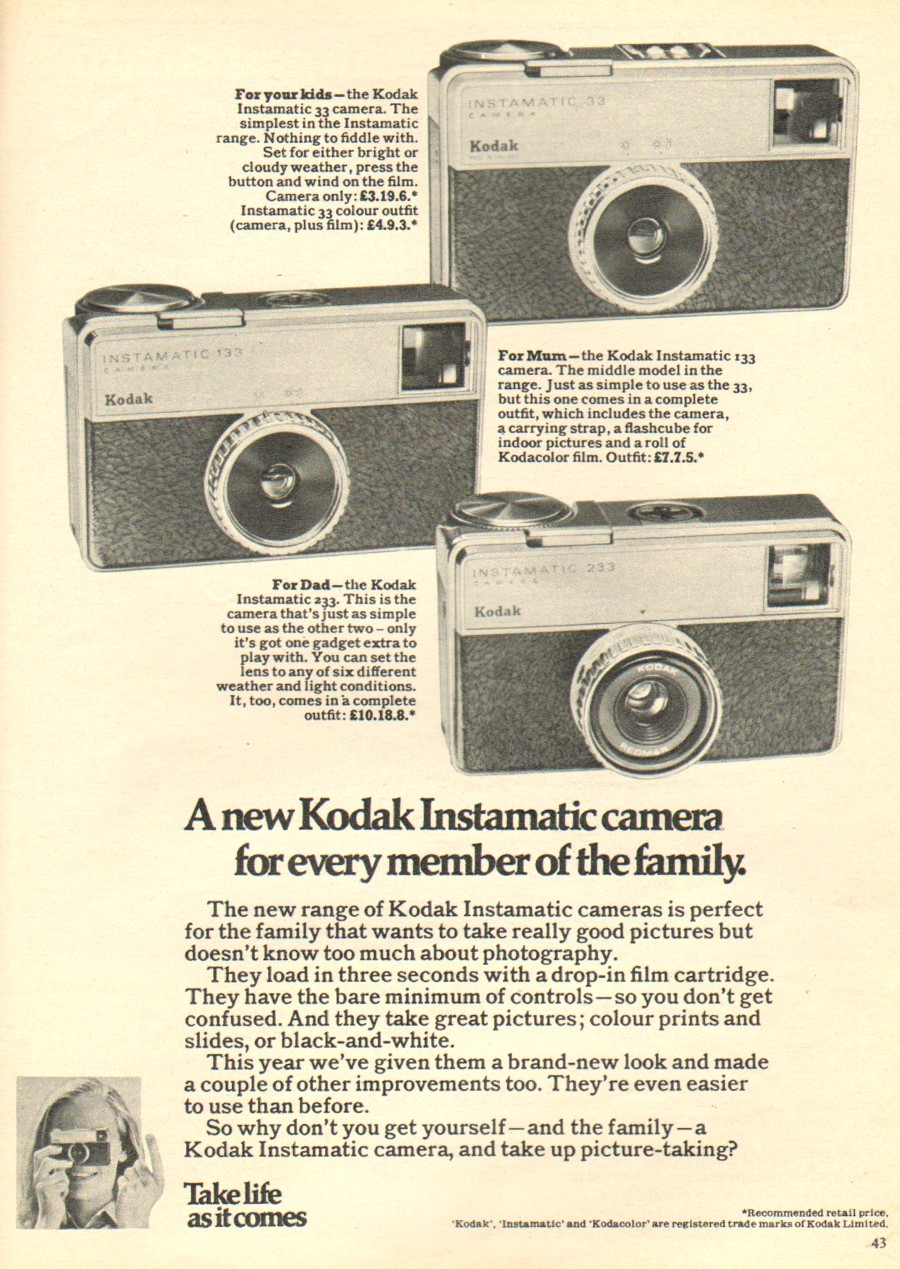
Woman's Weekly /
11th July 1969
This ad captures a point in consumer camera equipment where flashcubes (disposable flashes) were beginning to be included with cameras, rather than a flash being seen as a permanently separate element. I remember my parents using flashcubes, but all of my cameras have had electronic flashes included. The references to ‘drop in’ films probably signify the start of film cartridge use for non-instant cameras, something I remember being very common in the 1980s. Digital cameras have solved this problem, of course.
The model for kids makes sense, but the model for women heavily implies that women aren’t interested in taking the best photos they can. This could all be waved away as quaint old sexism, were it not for nonsense such as this from Bic, Lego’s appalling ‘Friends’ range, or this ‘girly laptop’.
Remind me what year we’re in?
Tags: blatant sexism, retail, social history










